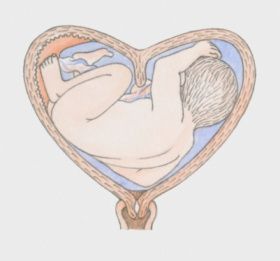The bicornuate uterus is also known as heart shaped uterus and this is known to be a congenital uterine malformation. This means that the uterus has two joint cavities, while in normal cases there is one single cavity.
The uterus in the shape of heart is usually caused by the uterus not forming properly in a woman’s early prenatal development. This usually happens in case of those women whose mother has been taking a medication called DES while being pregnant. Still there might be some other reasons as well that are yet unknown.
 In order to find out whether a woman has bicornuate uterus is through using a hysterosalpingogram or the procedure known as hysteroscopy.
In order to find out whether a woman has bicornuate uterus is through using a hysterosalpingogram or the procedure known as hysteroscopy.
In case during this procedure it is said that the woman in question has the condition, it is needed to be confirmed by three-dimensional ultrasound or laparoscopy.
According to the majority of the studies one of the effects of the uterus that is bicornuate is preterm labor and cervical insufficiency.
Both of them could cause second-trimester miscarriage or the death of the baby in case it is born too prematurely.
Nonetheless you should know that there are many women with this uterine malformation who carry their pregnancy to full term without any problems, so the risk varies from one case to the other.
There are some specialists who consider that the best solution in case of the bicornuate uteri is laparoscopic surgery, but usually doctors don’t really suggest surgery in this situation. Some of the patients may need cervical cerclage.
This is a kind of stitch placed in the cervix in order to prevent premature dilation. This is the main cause of premature labor or late pregnancy loss. The treatment differs in every case because of the physician and also because of the circumstances.
It is important to confirm the diagnosis of uterus in the shape of heart because in case of women with recurrent miscarriage there is a trend to misdiagnose the septate uteri as uterus that is bicornuate.
In case of the imaging studies these two congenital malformations might look similar, as in case of ultrasound and HSG. The difference between them is that the septate uterus is round at the top and it has only one cavity, while the other kind of uterus dips on the top, having a heart shape and two cavities.
Why is it important to make the difference between the two kinds of uterine malformations? First of all, the treatment for them is different. In some cases the bicornuate uterus cannot be treated at all, except for watching out for dilation. If the malformation is treated with surgery, it is a kind of reconstruction with the help of laparoscopy.
On the other hand, the septate uterine is usually treated by hysteroscopic surgery. Also we have to note that the bicornuate uterus isn’t considered a common factor in miscarriages, while the septate uterus is known to be a common cause. Nonetheless you should be looking out for both of them.



